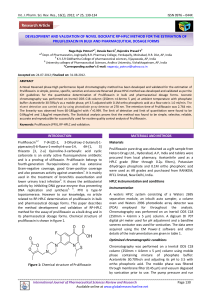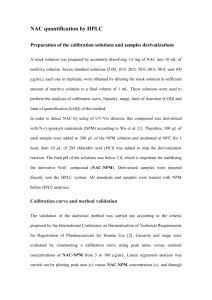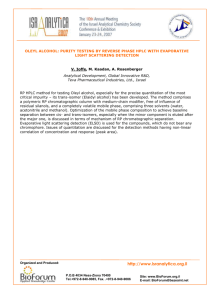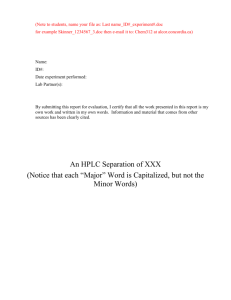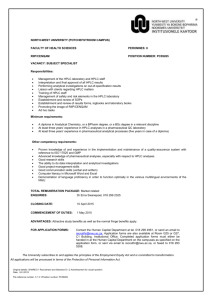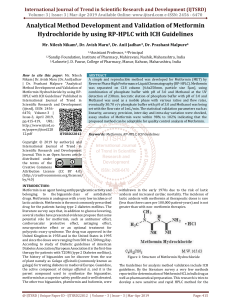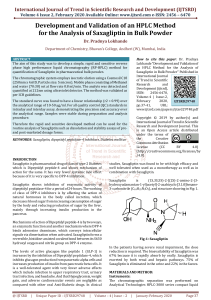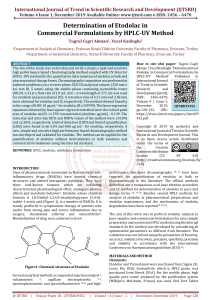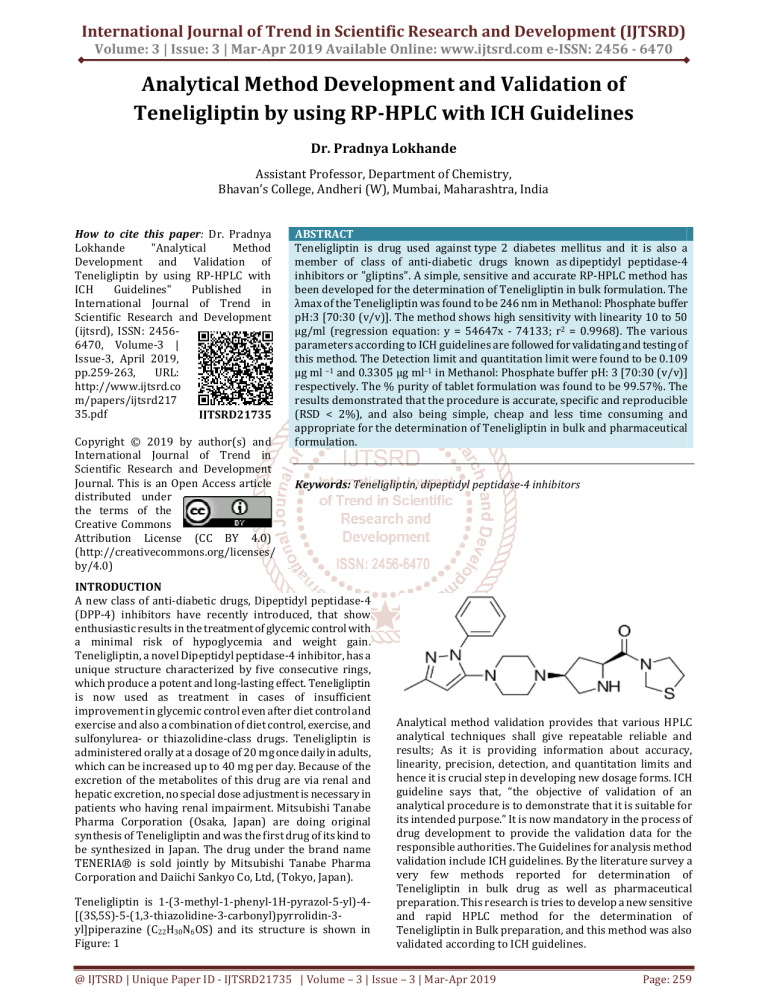
International Journal of Trend in Scientific Research and Development (IJTSRD)
Volume: 3 | Issue: 3 | Mar-Apr 2019 Available Online: www.ijtsrd.com e-ISSN: 2456 - 6470
Analytical Method Development and Validation of
Teneligliptin by using RP-HPLC with ICH Guidelines
Dr. Pradnya Lokhande
Assistant Professor, Department of Chemistry,
Bhavan’s College, Andheri (W), Mumbai, Maharashtra, India
How to cite this paper: Dr. Pradnya
Lokhande
"Analytical
Method
Development and Validation of
Teneligliptin by using RP-HPLC with
ICH
Guidelines"
Published
in
International Journal of Trend in
Scientific Research and Development
(ijtsrd), ISSN: 24566470, Volume-3 |
Issue-3, April 2019,
pp.259-263,
URL:
http://www.ijtsrd.co
m/papers/ijtsrd217
35.pdf
IJTSRD21735
Copyright © 2019 by author(s) and
International Journal of Trend in
Scientific Research and Development
Journal. This is an Open Access article
distributed under
the terms of the
Creative Commons
Attribution License (CC BY 4.0)
(http://creativecommons.org/licenses/
by/4.0)
ABSTRACT
Teneligliptin is drug used against type 2 diabetes mellitus and it is also a
member of class of anti-diabetic drugs known as dipeptidyl peptidase-4
inhibitors or "gliptins". A simple, sensitive and accurate RP-HPLC method has
been developed for the determination of Teneligliptin in bulk formulation. The
λmax of the Teneligliptin was found to be 246 nm in Methanol: Phosphate buffer
pH:3 [70:30 (v/v)]. The method shows high sensitivity with linearity 10 to 50
µg/ml (regression equation: y = 54647x - 74133; r2 = 0.9968). The various
parameters according to ICH guidelines are followed for validating and testing of
this method. The Detection limit and quantitation limit were found to be 0.109
µg ml –1 and 0.3305 µg ml–1 in Methanol: Phosphate buffer pH: 3 [70:30 (v/v)]
respectively. The % purity of tablet formulation was found to be 99.57%. The
results demonstrated that the procedure is accurate, specific and reproducible
(RSD < 2%), and also being simple, cheap and less time consuming and
appropriate for the determination of Teneligliptin in bulk and pharmaceutical
formulation.
Keywords: Teneligliptin, dipeptidyl peptidase-4 inhibitors
INTRODUCTION
A new class of anti-diabetic drugs, Dipeptidyl peptidase-4
(DPP-4) inhibitors have recently introduced, that show
enthusiastic results in the treatment of glycemic control with
a minimal risk of hypoglycemia and weight gain.
Teneligliptin, a novel Dipeptidyl peptidase-4 inhibitor, has a
unique structure characterized by five consecutive rings,
which produce a potent and long-lasting effect. Teneligliptin
is now used as treatment in cases of insufficient
improvement in glycemic control even after diet control and
exercise and also a combination of diet control, exercise, and
sulfonylurea- or thiazolidine-class drugs. Teneligliptin is
administered orally at a dosage of 20 mg once daily in adults,
which can be increased up to 40 mg per day. Because of the
excretion of the metabolites of this drug are via renal and
hepatic excretion, no special dose adjustment is necessary in
patients who having renal impairment. Mitsubishi Tanabe
Pharma Corporation (Osaka, Japan) are doing original
synthesis of Teneligliptin and was the first drug of its kind to
be synthesized in Japan. The drug under the brand name
TENERIA® is sold jointly by Mitsubishi Tanabe Pharma
Corporation and Daiichi Sankyo Co, Ltd, (Tokyo, Japan).
Teneligliptin is 1-(3-methyl-1-phenyl-1H-pyrazol-5-yl)-4[(3S,5S)-5-(1,3-thiazolidine-3-carbonyl)pyrrolidin-3yl]piperazine (C22H30N6OS) and its structure is shown in
Figure: 1
Analytical method validation provides that various HPLC
analytical techniques shall give repeatable reliable and
results; As it is providing information about accuracy,
linearity, precision, detection, and quantitation limits and
hence it is crucial step in developing new dosage forms. ICH
guideline says that, “the objective of validation of an
analytical procedure is to demonstrate that it is suitable for
its intended purpose.” It is now mandatory in the process of
drug development to provide the validation data for the
responsible authorities. The Guidelines for analysis method
validation include ICH guidelines. By the literature survey a
very few methods reported for determination of
Teneligliptin in bulk drug as well as pharmaceutical
preparation. This research is tries to develop a new sensitive
and rapid HPLC method for the determination of
Teneligliptin in Bulk preparation, and this method was also
validated according to ICH guidelines.
@ IJTSRD | Unique Paper ID - IJTSRD21735 | Volume – 3 | Issue – 3 | Mar-Apr 2019
Page: 259
International Journal of Trend in Scientific Research and Development (IJTSRD) @ www.ijtsrd.com eISSN: 2456-6470
MATERIALS AND METHOD:
Instruments:
The chromatographic separation was performed on
Analytical Technologies HPLC-3000 series compact liquid
chromatographic system integrated with a variable
wavelength programmable UV detector and a Rheodyne
injector equipped with 20µl fixed loop. A reverse phase C18
[Cosmosil C18 (250mm x 4.6ID, Particle size: 5 micron)] was
used. Model - UV 2012 double beam UV visible
spectrophotometer and Wenser High Precision Balance
Model: PGB 100 electronic balance was used for
Spectrophotometric determinations and weighing purposes
respectively.
Reagents and chemicals
Pharmaceutical grade pure Teneligliptin sample was
procured from Swaroop Drugs and Pharmaceuticals HPLC
grade Methanol and HPLC grade Water were procured from
Merck specialities private limited, Mumbai.
Chromatographic conditions
C18 [Cosmosil C18 (250mm x 4.6ID, Particle size: 5 micron)]
was used for the chromatographic separation at a detection
wave length of 246 nm. Methanol, Phosphate buffer pH 3 in a
ratio of 70:30 v/v was selected as mobile phase for elution
and same mixture was used in the preparation of standard
and sample solutions. The elution was monitored by
injecting the 20µl and the flow rate was adjusted to 0.8
ml/min.
Preparation of Mobile phase
Preparation of Phosphate buffer pH 3: Dissolve 1.36g of
Potassium dihydrogen orthophosphate & 2 ml of
triethylamine in 800ml of HPLC water, adjust the pH to 3
with orthophosphoric acid and add sufficient HPLC water to
produce 1000ml.The mobile phase was sonicated for 15 min
and filtered through a 0.45 µm membrane filter paper.
Preparation of Standard solutions
10mg Teneligliptin was accurately weighed and transferred
into 10 ml volumetric flasks, dissolved using mobile phase
and the volume was made up with the same solvent to obtain
primary stock solution of concentration 1000µg/ml of the
drug (Working stock solution).
Preparation of Sample Solution
20 tablets of Teneligliptin were initially weighed and
powdered and an amount equivalent to 10mg was accurately
weighed into a 10ml volumetric flask, mixed with 10ml of
mobile phase and sonicated for 5 min after making final
volume up to 10 ml with mobile phase. Then solution was
filtered through 0.45µm membrane filter. The solution
contains 1000µg/ml of Teneligliptin. From the above stock
solution 0.1ml aliquot was transferred in to a 10 ml
volumetric flask, volume was made up to the mark with
mobile phase to obtain a final concentration of 10 µg/ml of
metformin.
Optimization of RP-HPLC method
The HPLC method was optimized with an aim to develop a
estimation of Teneligliptin. Different mobile phases were
tried for the method optimization, but acceptable retention
times, theoretical plates and good resolution were observed
with Methanol, Phosphate buffer pH 3 (70:30 v/v) using C18
column [Cosmosil C18 (250mm x 4.6ID, Particle size: 5
micron)] Table:1 and a typical chromatograph of
teneligliptin was shown in figure 3.
Parameter
Flow Rate
Wavelength
Condition
Cosmosil C18 (250mm x 4.6ID,
Particle size: 5 micron)
70 : 30 (Methanol: Phosphate buffer
pH-3).
0.8 ml/min
246 nm
Injection Volume
Detector
20 µl
UV-3000-M
Column
Mobile Phase
Validation of the RP-HPLC method
Validation of the optimized method was performed
according to the ICH Q2 (R) guidelines.
1. Linearity
For the determination of linearity, appropriate aliquots were
pipetted out from 1000µg/ml (working stock solution). 0.1 –
0.5 ml was pipetted out in to a series of 10ml volumetric
flasks and volume was made up with the solvent to obtain
concentration ranging from 10-50µg/ml of metformin. Each
solution was injected in triplicate. Calibration curves were
plotted with concentration against observed peak areas
followed by the determination of regression equations and
calculation of the correlation coefficients. The calibration
curves for Teneligliptin were shown in figure 2 and their
corresponding linearity parameters given in table 2.
2. Accuracy
To ensure the reliability and accuracy of the recovery studies
were carried out by % recovery method (standard addition
method). A known quantity of pure drug was added to preanalysed sample and contents were reanalysed by the
proposed method and the percent recovery was reported.
The results were given in tables 3 and 4.
3. Precision
The repeatability of the method was verified by calculating
the % RSD of three replicate injections of 100%
concentration (30µg/ml of Teneligliptin) on the same day
and for intraday precision % RSD was calculated from
repeated studies. The results were given in table 5.
4. Limit of Quantitation (LOQ) and Limit of Detection
(LOD)
The LOD and LOQ were calculated from the slope(s) of the
calibration plot and the standard deviation (SD) of the peak
areas using the formulae LOD = 3.3 s/s and LOQ = 10 s/s.
5. Robustness
Robustness was verified by altering the chromatographic
conditions like mobile phase composition, flow rate,
detection wave length, etc. and the % RSD should be
reported. In the operational conditions Small changes were
allowed and the extent to which the method was robust was
determined. A deviation of ± 2 nm in the detection wave
length and ± 0.1 ml/min in the flow rate, were tried
individually. Solutions of 100% test concentration with the
specified changes in the operational conditions were injected
to the instrument in triplicate. % RSD was reported in the
table 6.
6. Assay of marketed formulation
20 tablets of teneligliptin were weighed and crushed into
fine powder. The average weight of the tablet was calculated
@ IJTSRD | Unique Paper ID - IJTSRD21735 | Volume – 3 | Issue – 3 | Mar-Apr 2019
Page: 260
International Journal of Trend in Scientific Research and Development (IJTSRD) @ www.ijtsrd.com eISSN: 2456-6470
and the amount equivalent to 10 mg of pure teneligliptin was
dissolved in 10 ml of solvent. From this stock solution 30
ppm dilution was prepared and injected. The % purity was
calculated by comparing the result with result obtained from
30 ppm standard drug and are reported in table 7.
7. System suitability
It was ensuring that from the system suitability parameters,
the method can generate results of acceptable accuracy and
precision. System suitability was carried out with three
injections of solution of 30 µl/ml of Teneligliptin in to the
chromatographic system. Number of theoretical plates (N)
obtained and calculated tailing factor (T) was reported in
table 8.
RESULT AND DISCUSSION
Linearity:
It was clarified from the analytical method linearity as the
ability of the method to obtain test results that are directly
proportional to the analyte concentration, within a specific
range. The peak area obtained from the HPLC
chromatograph was plotted against corresponding
concentrations to obtain the calibration graph. The results of
linearity study (Figure 1) gave linear relationship over the
concentration range of 10 - 50 µg/ml for metformin. From
the regression analysis, a linear equation was obtained y =
54647 x - 74133, and the goodness-of-fit (r2) was found to be
0.9968, indicating a linear relationship between the
concentration of analyte and area under the peak.
Conc. (µg/ml)
Peak Area
10
465398
20
974059
30
1629073
40
2146136
50
2611705
Sr. No.
1
Conc.
10
10
10
Area
465631
465398
464934
30
30
30
1632648
1629073
1627469
50
50
50
2608954
2611705
2613765
2
3
Sr. No.
1
2
3
%Composition
50% Recovery
100% Recovery
150% Recovery
Accuracy
The accuracy of the method determines the closeness of
results obtained by that method to the true value. From the
results of accuracy testing it was showed that the method is
accurate within the acceptable limits. The % RSD is
calculated for the Teneligliptin and all the results are within
limits. Acceptable accuracy was within the range and not
more than 2.0% RSD, as demonstrated in Table -3.
Standard Deviation
Mean
SD
Accuracy
% SD
Precision
% SRD
465321
354.8224908
0.0762533
0.076253273
1629730
2651.272713
0.1626817
0.162681715
2611474.667
2413.756478
0.0924289
0.092428868
Area of Standard
1629073
2146136
2611705
Area of Sample
1633181
2112757
2619697
% Recovery
100.252168
98.44469316
100.306007
Precision
Precision is “the closeness of results obtained from multiple sampling of the same homogeneous sample under the prescribed
conditions,” and it is expressed in the form of relative standard deviation. The repeatability, intra-day and inter-day precision
results are shown in the table 5. The RSD were calculated for all the results are within limits. Precision was not more than 2.0%
RSD, as demonstrated in Table 5.
@ IJTSRD | Unique Paper ID - IJTSRD21735 | Volume – 3 | Issue – 3 | Mar-Apr 2019
Page: 261
International Journal of Trend in Scientific Research and Development (IJTSRD) @ www.ijtsrd.com eISSN: 2456-6470
Interday
Injection
Area
1
1629073
Day 1
2
1622953
3
1634124
1
1628514
Day 2
2
1634567
3
1624254
Intraday
Injection
Area
1
1628102
Morning
2
1629073
3
1626134
1
1627963
Evening
2
1634124
3
1629163
Mean
%RSD
1628914
0.30%
%RSD
1629093
0.17%
LOD and LOQ
The LOD and LOQ were calculated by the equations, LOD
and LOQ =
where, Standard
Deviation taken from accuracy and slope is from linearity . Based on these equations, the calculated LOD and LOQ values for
Teneligliptin were 0.109 and 0.3305 µg/ml, respectively.
Robustness
Robustness of the method reflects that the results are unaffected or reliable even if the minute changes in the method
parameters. Here, the flow rate and wavelength were slightly changed to lower and higher sides of the actual values to find if
the change in the peak area and retention time were within limits. The results obtained with changes in the parameters on a
30µg/mL solution are as shown in Table No. 6.
Assay of marketed formulation
The % purity obtained from the formulation was given in table 7. And it was found that the Assay results of teneligliptin are
within the limits.
% Composition Area of Standard Area of Sample % Assay
% Assay
1629073
1622184
99.5771
System Suitability Parameters:
System suitability was performed by injecting three replicate injections of 100% test concentration, number of theoretical
plates, asymmetry factor were satisfactory. The chromatographs confirm the presence of Teneligliptin at 4.2 min without any
interference.
Parameter
No. of Theoretical Plates
Tailing Factor
CONCLUSION:
The proposed method was found to be simple, precise,
accurate, rapid and specific for determination of
Teneligliptin from pure and its dosage forms. The mobile
phase used for method development is very simple to
prepare and economical also. The sample recoveries in the
Observed Value
9520
1.15
Limits
< 2000
< 1.75
formulation were showing good results with their respective
label claims and it was found that there is no interference of
formulation excipients in the estimation. And hence, this
method can be easily and conveniently adopted for routine
analysis of Teneligliptin in pure form and its dosage form.
@ IJTSRD | Unique Paper ID - IJTSRD21735 | Volume – 3 | Issue – 3 | Mar-Apr 2019
Page: 262
International Journal of Trend in Scientific Research and Development (IJTSRD) @ www.ijtsrd.com eISSN: 2456-6470
ACKNOWLEDGEMENT
Author gratefully acknowledges Mr. Rohan Pawar, the
Director, the RAP Analytical Research and Training Center
for their kind help and providing all necessary facilities and
also for providing the gift sample of Teneligliptin.
REFERNCES
[1] T. N. V. Ganesh Kumar, S. Vidyadhara, Niteen Ashok
Narkhede, Y. Sai Silpa and M. Rajya Lakshmi, Method
development, validation and stability studies of
Teneligliptin by RP-HPLC and identification of
degradation products by UPLC tandem mass
spectroscopy, Journal of Analytical Science and
Technology, 01-08. (02-08-2017)
[2] Martindale, The complete drug reference.
36th Edition.Vol. I. London (UK): Pharmaceutical Press
(An Imprint of RPS Publishing); 2009.
[3] Vishnu C. Shinde, Kiran B. Aher, Girija b. Bhavar, Sachin
J. Kakad and Sanjay R. Chaudhari, Development and
validation of UV spectrophotometric method and high
performance thin layer chromatographic (HPTLC)
method for estimation of Teneligliptin Hydrobromide
in pharmaceutical preparation, Der Pharmacia Lettre,
Volume 8 (8), 2016, 291-301. (03-08-2017)
[4] Atul T. Hemke, E. A. Rathod, K. R. Gupta, M. J. Umekar,
HPLC and UV-Spectrophotometric estimation of
Teneligliptin from tablet dosage form, Asian Journal of
Pharmaceutical Analysis and Medicinal Chemistry,
Volume 4(3), 2016, 148- 156. (02-08-2017)
[5] Manjusha D. Karad and V. D. Barhate.
Spectrophotometric determination of an anti- diabetic
drug Teneligliptin bulk and pharmaceutical
formulations. World Journal Pharmaceutical Research;
Volume. 5(5), 2016, 1625-1632 (02-08-2017)
[6] Beckett AH, Stenlake JB. Instrumental methods in the
development and use of medicines.In, Practical
pharmaceutical chemistry (Part2), 4th edition. New Delhi,
CBS Publishers and Distributors, 2005
[7] Chunduri R.H.B, Dannana G.S. Development
and validation of LC-MS/MS method for quantification
of teneligliptin in human plasma and its application to
a pharmacokinetic study, World Journal of Pharmacy
and Pharmaceutical Sciences, 2016;5(5):833-50.
@ IJTSRD | Unique Paper ID - IJTSRD21735 | Volume – 3 | Issue – 3 | Mar-Apr 2019
Page: 263

